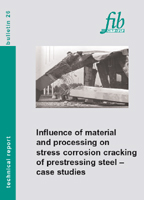Influence of material and processing on stress corrosion cracking of prestressing steel
Technical report (44 pages, ISBN 978-2-88394-066-6, October 2003)
fib Bulletin No. 26
Title: Influence of material and processing on stress corrosion cracking of prestressing steel - case studies
Category: Technical report
Year: 2003
Pages: 44
Format approx. DIN A4 (210X297 mm)
ISBN: 978-2-88394-066-6
Abstract:
This report is a review of selected failures in concrete structures in which prestressing steels break in a brittle way due to stress corrosion cracking. Most cases are from the German experience over a period of about 30 years. Analysis of these failures shows that they are often due to an accumulation of causes such as poor design, errors during construction, careless detailing and, in some cases, use of unsuitable materials. This report will have achieved its purpose if it serves to avoid these past errors and encourages the development of new ways to protect, test and regulate prestressing steels. The report is complemented with comments on the properties and corrosion behaviour of different types of prestressing steels.
The goal of the study is to provide objective arguments for the discussion of failures that have occurred due to corrosion induced failure of prestressing steel. In such a way the general regulation given in DIN with respect to reinforcement for robustness may eventually be proven inappropriate. The general building authority approval for prestressed hollow filler block floors already supports such an idea. It is well known that the hollow block floor industry works without any reinforcing steel. The regulations in the standards should not limit in particular the use of these types of prestressing steel (cold-formed wires, strands) which have proven not associated with any substantial failures cases reported in the last 35 years.
The report reviews the historical development with respect to corrosion induced failure of prestressing steel. Concerning the circumstances of the failure examples, this review partly reflects a specific problem in Germany. Also reviewed are other known interregional examples of failure which are incorrectly attributed to the prestressed construction method. All cases considered are discussed and the failure reasons thoroughly evaluated, also with reference to the results of most recent research.
Another question addressed is whether one should be concerned over corrosion induced retarded failure even when using new generation prestressing steel with correct corrosion protection.
Finally a contribution to the following very important question is presented: Do the future prestressed structures possess enough safety against structural failure if they are constructed without reinforcement for robustness but otherwise comply completely with the design standards?
To aid a better understanding of this short report on typical failure cases and their origins, the main conditions are set out for corrosion-induced failure of prestressing steel in technical applications. The properties of different types of prestressing steel and their application limits are given in a special section dealing with the influence of building materials on damage development.
This report will be of interest to all involved in the construction process. Fundamental scientific discussion has been avoided by reference to well accredited detailed information in the technical literature.
This Bulletin N° 26 was approved as an fib Technical Report in April 2003 by fib Task Group 9.5, Durability of prestressing materials, in Commission 9, Reinforcing and prestressing materials and systems.
Download the copyright page (= list of authors) as a PDF file.
Download the table of contents as a PDF file.



